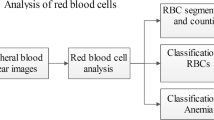Abstract
Traditional fecal erythrocyte detection is performed via a manual operation that is unsuitable because it depends significantly on the expertise of individual inspectors. To recognize human erythrocytes automatically and precisely, automatic segmentation is very important for extraction of characteristics. In addition, multiple recognition algorithms are also essential. This paper proposes an algorithm based on morphological segmentation and a fuzzy neural network. The morphological segmentation process comprises three operational steps: top-hat transformation, Otsu’s method, and image binarization. Following initial screening by area and circularity, fuzzy c-means clustering and the neural network algorithms are used for secondary screening. Subsequently, the erythrocytes are screened by combining the results of five images obtained at different focal lengths. Experimental results show that even when the illumination, noise pollution, and position of the erythrocytes are different, they are all segmented and labeled accurately by the proposed method. Thus, the proposed method is robust even in images with significant amounts of noise.










Similar content being viewed by others
References
Berkson, J., Magath, T. B., and Hurn, M., Laboratory standards in relation to chance fluctuations of the erythrocyte count as estimated with the hemocytometer. J. Am. Stat. Assoc. 30:416–426, 1935. doi:10.1080/01621459.1935.10502287.
Dein, F. J., Wilson, A., Fischer, D., and Langenberg, P., Avian leucocyte counting using the hemocytometer. J. Zoo. Wildl. Med. 25(3):432–437, 1994.
Fulwyler, M. J., Electronic separation of biological cells by volume. Science 150(3698):910–911, 1965.
Petersen, S. E., Bichel, P., and Lorentzen, M., Flow-cytometric demonstration of tumour-cell subpopulations with different DNA content in human colo-rectal carcinoma. Eur. J. Cancer 15:383–386, 1979.
Zhang, J., Lin, Y., Liu, Y., Li, Z., Li, Z., Hu, S., Liu, Z., Lin, D., and Wu, Z., Cascaded-automatic segmentation for schistosoma japonicum eggs in images of fecal samples. Comput. Biol. Med. 52:18–27, 2014.
Yang, Y. S., Park, D. K., Kim, H. C., Choi, M.-H., and Chai, J.-Y., Automatic identification of human helminth eggs on microscopic fecal specimens using digital image processing and an artificial neural network. IEEE Trans. Biomed. Eng. 48(6):718–730, 2001.
Soille, P., Morphological image analysis-principle and applications (Springer, 2003).
Madhloom, H. T., Kareem, S. A., and Ariffin, H., An image processing application for the localization and segmentation of lymphoblast cell using peripheral blood images. J. Med. Syst. 36(4):2149–2158, 2012.
Bai, X., Zhou, F., and Xue, B., Fusion of infrared and visual images through region extraction by using multi scale center surround top-hat transform. Opt. Express 19(9):8444–8457, 2011.
Zeng, M., Li, J., and Peng, Z., The design of Top-Hat morphological filter and application to infrared target detection. Infrared Phys. Technol. 48:67–76, 2006.
Ostu, N., A Threshold selection method from gray-level histograms. IEEE. Trans. Syst. Man. Cybenet. SMC-9(1):62–66, 1979.
Sezgin, M., and Sankur, B., Survey over image threshold techniques and quantitative performance evaluation. J. Electron. Imag. 13(1):146–165, 2004.
Avci, D., Leblebiciogdu, M. K., Poyraz M., Dogantekin, E., A new method based on adaptive discrete wavelet entropy energy and neural network classifier (ADWEENN) for recognition of urine cells from microscopic images independent of rotation and scaling. J. Med. Syst. 38(7):2014. doi: 10.1007/s10916-014-0007-3.
Bezdek, J. C., Pattern recognition with fuzzy objective function algorithms. Plenum Press, New York, 1981.
Acknowledgments
This research is supported partly by National Natural Science Foundation of China (61405028 and 61205004) and Central Universities (University of Electronic Science and Technology of China) Fundamental Research Funds (ZYGX2013J065) and the funds of Guangdong-HongKong Break through Bidding Project in Key Areas (20122205106 and 20091683).
I would like to express my gratitude to professor Yutang Ye and all those who have helped me during the writing of this thesis.
Author information
Authors and Affiliations
Corresponding author
Additional information
This article is part of the Topical Collection on Systems-Level Quality Improvement
Rights and permissions
About this article
Cite this article
Liu, L., Lei, H., Zhang, J. et al. Automatic Identification of Human Erythrocytes in Microscopic Fecal Specimens. J Med Syst 39, 146 (2015). https://doi.org/10.1007/s10916-015-0334-z
Received:
Accepted:
Published:
DOI: https://doi.org/10.1007/s10916-015-0334-z




